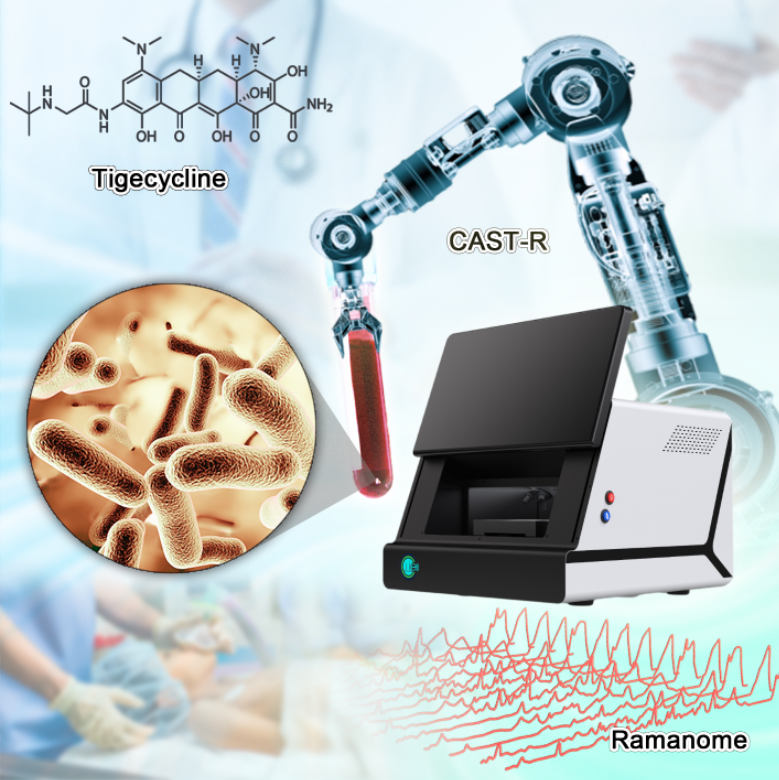When treating patients with acute infections, healthcare professionals must be able to quickly and properly determine which antibiotics are most effective in combating the disease.
 The automated CAST-R workflow supports rapid and accurate treatment of pathogen infections in clinics. Image Credit: LIU Yang.
The automated CAST-R workflow supports rapid and accurate treatment of pathogen infections in clinics. Image Credit: LIU Yang.
A study team headed by experts from the Chinese Academy of Sciences (CAS) Qingdao Institute of Bioenergy and Bioprocess Technology (QIBEBT) and Peking Union Medical College Hospital has created an automated approach for determining the optimum antibiotics at the correct dose.
The Clinical Antimicrobials Susceptibility Test Ramanometry (CAST-R) is an automated method that uses Raman microspectroscopy, a spectroscopic technique for identifying particular compounds. It has a lot of promise in terms of treating human bloodstream infections.
Their findings were published in the journal mLife on April 18th, 2022.
Antimicrobial susceptibility tests (ASTs) have typically been the standard for determining which antibiotic is most successful in treating a specific bacterium or fungus. They are, however, time-consuming, labor-intensive, and insecure.
Sepsis, a kind of acute blood infection, has a death rate of 20–40%, and each hour spent waiting for an AST report increases the mortality rate by 7.6%. Tigecycline is an antimicrobial used to treat blood infections as a last option.
Unfortunately, resistance to tigecycline has emerged in many blood pathogens.”
Qiwen Yang, Study Senior Author and Associate Director, Department of Clinical Laboratory, Peking Union Medical College Hospital
Traditional ASTs for tigecycline have been slower, inefficient, and often inaccurate. The AST of tigecycline takes 36–48 hours to complete from the time a positive blood culture is obtained to the time the AST findings are available.
Rapid and reliable methods for tigecycline resistance are urgent.”
Pengfei Zhu, Scientist, Qingdao Institute of Bioenergy and Bioprocess Technology, Chinese Academy of Sciences
As a result, the study team used tigecycline as its main model and developed an automated CAST-R system that performed AST for bloodstream infections utilizing D2O-probed Raman microspectroscopy technology. CAST-R can enable doctors in determining which antibiotic to use and how much to provide in a timely manner.
For sample preparation, the team utilizes a liquid robot, and for data acquisition and quality control, researchers use a machine learning-based control method. Thousands of Raman peaks provided valuable information about cells in each Single-Cell Raman Spectrum (SCRS) generated by their approach, similar to a chemical fingerprint of each cell.
The three-hour CAST-R procedure demonstrated excellent accuracy and was nearly ten times quicker than the traditional AST technique in their tests. Their method handled 96 antibiotic-exposure processes in parallel and yielded Raman spectra of comparable quality to the more time-consuming manual method.
“The automation, speed, reliability, and broad applicability suggest CAST-R as a clinically valuable AST for bloodstream infections,” stated Lihui Ren, an associate professor working at the QIBEBT, CAS.
The strengths of a SCRS, which also include information richness, single-cell resolution, and ability to couple with downstream single-cell sequencing, have yet to be fully exploited in this study, and that will be our priority ahead.”
Jian Xu, Study Senior Author and Director, Single-Cell Center, Qingdao Institute of Bioenergy and Bioprocess Technology, Chinese Academy of Sciences
The team intends to examine these advantages and enhance the CAST-R technique. “As we refine the CAST-R workflow process, our goal is to provide a series of new applications in clinical diagnosis based on microbial single-cell technologies, in order to combat superbugs and support personalized treatment of infections,” Qiwen Yang concluded.
Source:
Journal reference:
Zhu, P., et al. (2022) Rapid, automated, and reliable antimicrobial susceptibility test from positive blood culture by CAST-R. mLife. doi.org/10.1002/mlf2.12019.